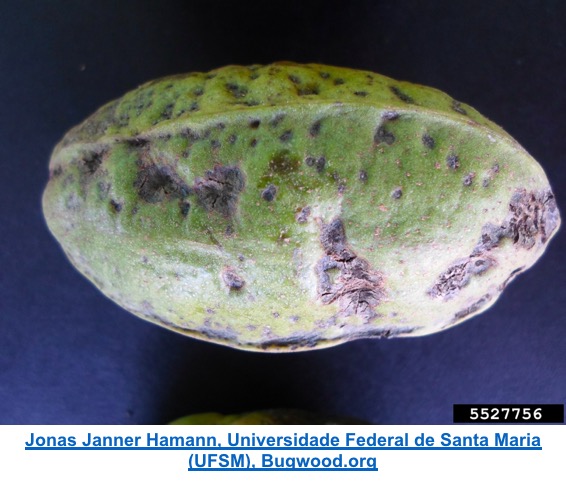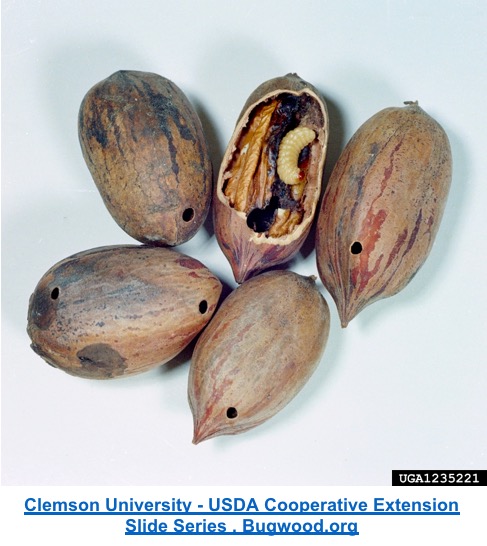Fall of the Pecans
go.ncsu.edu/readext?744885
en Español / em Português
El inglés es el idioma de control de esta página. En la medida en que haya algún conflicto entre la traducción al inglés y la traducción, el inglés prevalece.
Al hacer clic en el enlace de traducción se activa un servicio de traducción gratuito para convertir la página al español. Al igual que con cualquier traducción por Internet, la conversión no es sensible al contexto y puede que no traduzca el texto en su significado original. NC State Extension no garantiza la exactitud del texto traducido. Por favor, tenga en cuenta que algunas aplicaciones y/o servicios pueden no funcionar como se espera cuando se traducen.
Português
Inglês é o idioma de controle desta página. Na medida que haja algum conflito entre o texto original em Inglês e a tradução, o Inglês prevalece.
Ao clicar no link de tradução, um serviço gratuito de tradução será ativado para converter a página para o Português. Como em qualquer tradução pela internet, a conversão não é sensivel ao contexto e pode não ocorrer a tradução para o significado orginal. O serviço de Extensão da Carolina do Norte (NC State Extension) não garante a exatidão do texto traduzido. Por favor, observe que algumas funções ou serviços podem não funcionar como esperado após a tradução.
English
English is the controlling language of this page. To the extent there is any conflict between the English text and the translation, English controls.
Clicking on the translation link activates a free translation service to convert the page to Spanish. As with any Internet translation, the conversion is not context-sensitive and may not translate the text to its original meaning. NC State Extension does not guarantee the accuracy of the translated text. Please note that some applications and/or services may not function as expected when translated.
Collapse ▲A common question over the past few weeks involves premature drop of pecans. Typically, mature pecans fall from trees when shucks open around November. Nuts falling from trees in September or early October (or earlier) are often green and still retain the shuck tightly attached to the nut.
So why do the nuts fall prematurely? There could be several reasons, including plant physiology (pollination, nutrient requirement, canopy load), environmental stresses (drought, excess water), diseases (scab, powdery mildew, etc.) and insect pests (pecan weevil, twig girdlers, etc.). One of the most common issues I see in the Extension office involves Pecan Scab disease. Scab is much more prevalent during wet years, and results in dark lesions that can form on leaves, twigs, and nuts. Lesions on shucks form sunken dark spots that can coalesce over time and result in premature nut drop.
Variety resistance is important for scab control, as some pecan varieties are very susceptible to this disease. However, if you have large mature pecan trees, then choosing a different variety is obviously not possible. Fungicide applications are available to control scab, but the cost and ability of a homeowner to apply them make it impractical, which leaves us with one option, sanitation. By removing leaves, twigs, and pecans that have fallen during the winter, we can help eliminate possible infection sources for the coming year. Disease occurrence is still possible, but at least you can reduce that possibility. Good sunlight penetration and airflow into the tree canopy may also help reduce infection, but would require proper tree management (training & pruning, spacing, etc.) that most homeowners rarely provide.
Some insect pests like pecan weevils can cause premature nut drop. Pecans that have fallen may contain several developing larvae that feed on the nut and exit the shell, leaving an unfilled nut that contains a hole. The larvae move into the soil where they eventually pupate and form into an adult. This process may take several years, but adult insects emerge annually from August through September, where they migrate to trees to feed and mate. Monitoring for these insects helps to determine when they are most active and when an insecticide application might provide some control. However, just like with fungicide applications, uniform control is limited since the most effective applications should be made to the entire tree. Soil applied insecticides might help reduce emerging adults, but the long period of emergence makes this difficult. Your best option as a homeowner is to pick up fallen nuts and remove them from the area before larvae have a chance to leave the nut and enter the soil.
Alternate bearing is often confused with premature nut drop. Pecans have a habit of producing a heavy bearing year followed by a light year of production. There are several factors that contribute to this phenomenon, which are related to conditions of growth and stress that result in less carbohydrate storage. Production the following year is then reduced as the tree has fewer reserves to draw from.
If you would like to learn more about pecan production in North Carolina, please view the NC State Extension production note titled “Growing Pecans in North Carolina”. If you would like to discuss your pecan issues or other related garden topics, please contact Daniel Simpson at daniel_simpson@ncsu.edu or 252-745-4121.






